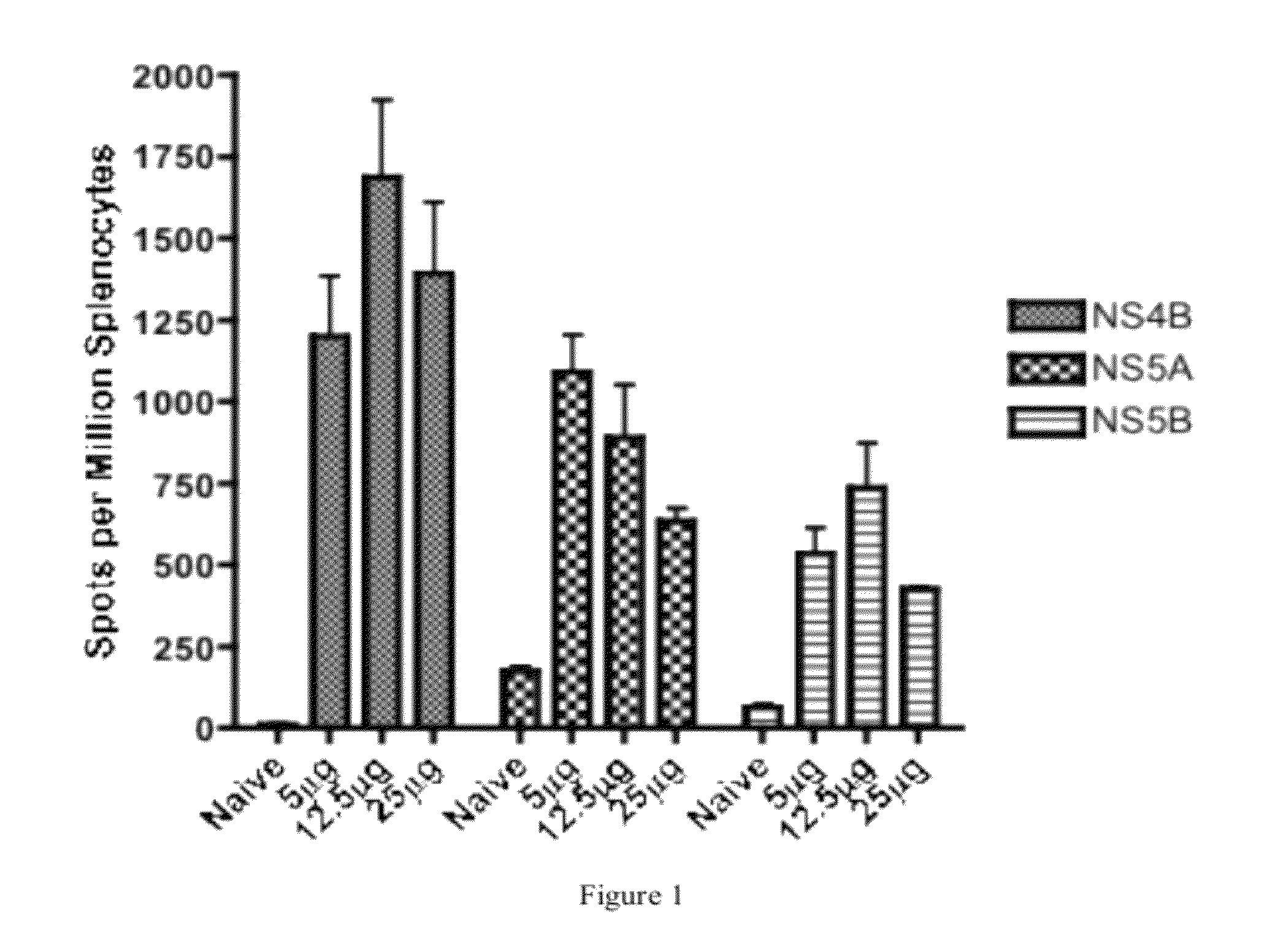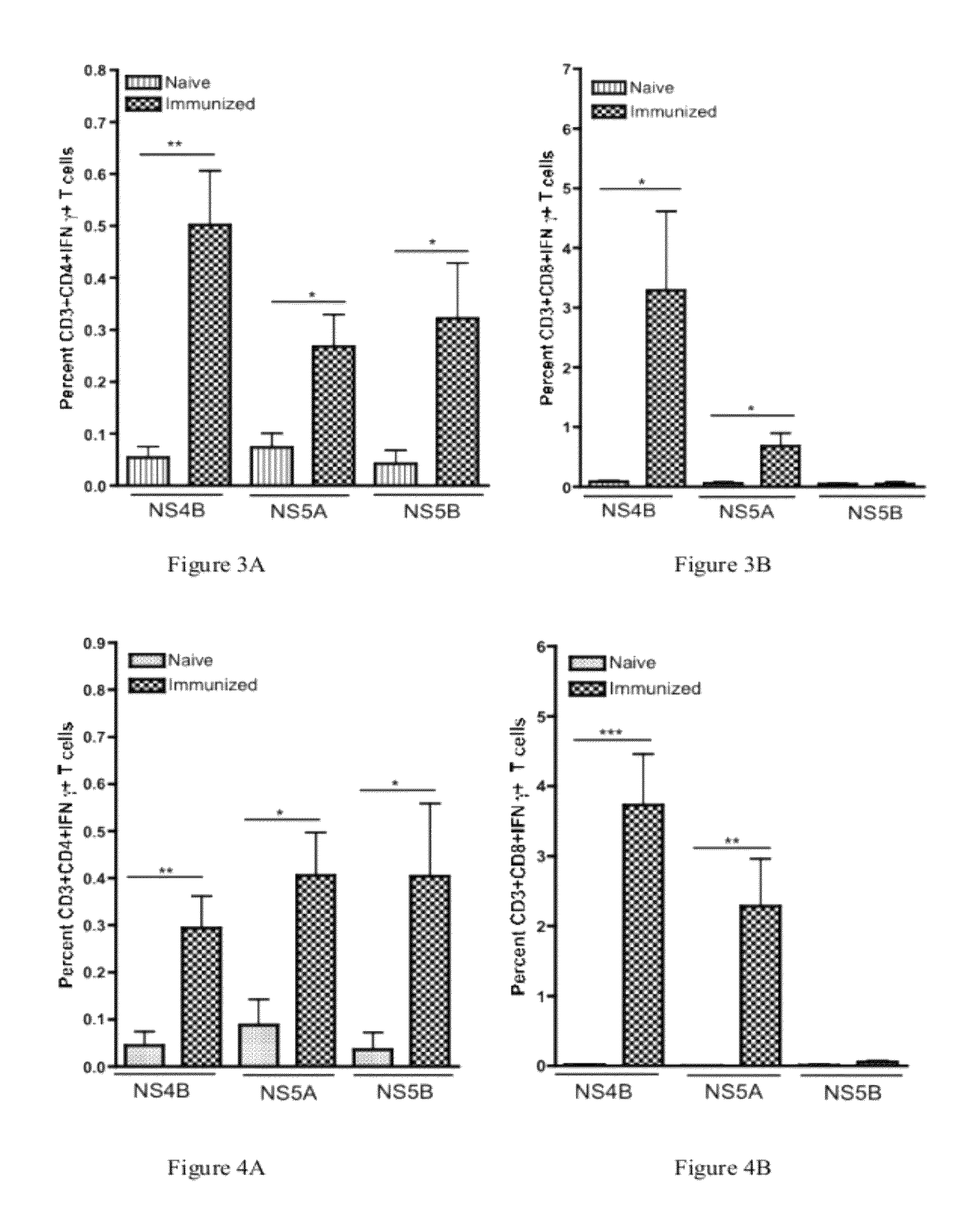HCV vaccines and methods for using the same
a technology of hcv and antigen, applied in the direction of viruses, peptides, drug compositions, etc., can solve the problems of no prophylactic or therapeutic vaccine for hcv, no protection against reinfection, and difficult treatment of hcv infection
- Summary
- Abstract
- Description
- Claims
- Application Information
AI Technical Summary
Benefits of technology
Problems solved by technology
Method used
Image
Examples
example
Example 1
Design and Expression of pConNS4B, pConNS5A and pConNS5B
[0084]The HCV genotype 1a consensus sequences for HCV proteins NS4B, NS5A and NS5B were generated from 170 different sequences obtained from the Los Alamos National Laboratory HCV Sequence Database. Several modification were then made to the consensus constructs in order to enhance their expression and detection, including the addition of IgE leader sequence at the C-term and an HA-tag at the N-term of each construct. Additionally, each construct was further modified through codon and RNA optimization using GeneOptimizer™ (GENEART, Germany) and subcloned in to the clinical expression vector pVAX under the control a CMV promoter. The final constructs were named pConNS4B, pConNS5A and pConNS5B (plasmid maps shown in FIGS. 8A-8C).
[0085]Protein expression of each construct was confirmed through transient transfection of human RD muscle cells with each individual construct. RD muscles cells were transiently transfected with...
example 2
Immunization of C57BL / 6 Mice with pConNS4B, pConNS5A and pConNS5B Induces Strong Cellular Immune Responses
[0087]Once expression of the constructs was confirmed, C57BL / 6 mice were immunized in order to determine immunogenicity of the constructs. Six to eight week old female C57BL / 6 mice were purchased from Jackson Laboratories and were maintained in accordance with the National Institutes of Health and the University of Pennsylvania Institutional Care and Use Committee (IACUC) guidelines. Animals were separated into three different dosing groups for each individual construct with five animals per group. The animals were immunized intramuscularly with either 5 μg, 12.5 μg or 25 μg of pConNS4B, pConNS5A or pConNS5B, followed by electroporation.
[0088]Electroporation was performed using the CELLECTRA™ adaptive constant current electroporation device and electrode arrays (Inovio Pharmaceuticals, Inc., Blue Bell, Pa.).
[0089]The animals received a total of two immunizations, two weeks apart...
example 3
Immunization Induced NS4B-, NS5A- and NS5B-Specific T Cells were Detected Within the Liver Following Intramuscular Immunization
[0094]Mice were immunized as previously described in Example 1, above. One week following the final immunization, the animals were sacrificed. Following sacrifice, the livers were isolated and individually pulverized using a Stomacher machine. The resulting mixture was strained and treated 5 min with 10 ml ACK lysis buffer (Bioscience) in order to clear the RBCs. The mixture was pelleted and the hepatocytes were separated from the lymphocytes through the use of a 35% percoll gradient. The pelleted lymphocytes were resuspended in complete media. Experiments were performed with and without liver perfusion, and no differences were observed.
[0095]T cells were isolated from each liver and were stimulated with over-lapping peptides corresponding to each individual construct. Immunization induced HCV-specific T cells were identified by IFN-γ expression detected thr...
PUM
| Property | Measurement | Unit |
|---|---|---|
| Tm | aaaaa | aaaaa |
| temperature | aaaaa | aaaaa |
| temperature | aaaaa | aaaaa |
Abstract
Description
Claims
Application Information
 Login to View More
Login to View More - R&D
- Intellectual Property
- Life Sciences
- Materials
- Tech Scout
- Unparalleled Data Quality
- Higher Quality Content
- 60% Fewer Hallucinations
Browse by: Latest US Patents, China's latest patents, Technical Efficacy Thesaurus, Application Domain, Technology Topic, Popular Technical Reports.
© 2025 PatSnap. All rights reserved.Legal|Privacy policy|Modern Slavery Act Transparency Statement|Sitemap|About US| Contact US: help@patsnap.com



